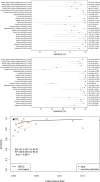Implementation outcomes of HIV self-testing in low- and middle- income countries: A scoping review
- PMID: 33939722
- PMCID: PMC8092786
- DOI: 10.1371/journal.pone.0250434
Implementation outcomes of HIV self-testing in low- and middle- income countries: A scoping review
Abstract
Introduction: HIV self-testing (HIV-ST) is an effective means of improving HIV testing rates. Low- and middle-income countries (LMIC) are taking steps to include HIV-ST into their national HIV/AIDS programs but very few reviews have focused on implementation in LMIC. We performed a scoping review to describe and synthesize existing literature on implementation outcomes of HIV-ST in LMIC.
Methods: We conducted a systematic search of Medline, Embase, Global Health, Web of Science, and Scopus, supplemented by searches in HIVST.org and other grey literature databases (done 23 September 2020) and included articles if they reported at least one of the following eight implementation outcomes: acceptability, appropriateness, adoption, feasibility, fidelity, cost, penetration, or sustainability. Both quantitative and qualitative results were extracted and synthesized in a narrative manner.
Results and discussion: Most (75%) of the 206 included articles focused on implementation in Africa. HIV-ST was found to be acceptable and appropriate, perceived to be convenient and better at maintaining confidentiality than standard testing. The lack of counselling and linkage to care, however, was concerning to stakeholders. Peer and online distribution were found to be effective in improving adoption. The high occurrence of user errors was a common feasibility issue reported by studies, although, diagnostic accuracy remained high. HIV-ST was associated with higher program costs but can still be cost-effective if kit prices remain low and HIV detection improves. Implementation fidelity was not always reported and there were very few studies on, penetration, and sustainability.
Conclusions: Evidence supports the acceptability, appropriateness, and feasibility of HIV-ST in the LMIC context. Costs and user error rates are threats to successful implementation. Future research should address equity through measuring penetration and potential barriers to sustainability including distribution, cost, scale-up, and safety.
Conflict of interest statement
The authors have declared that no competing interests exist.
Figures






References
-
- World Health Organization (WHO). WHO Recommends HIV Self-Testing. Vol. 0, Policy Brief. 2016. p. 1–2.
-
- Figueroa C, Johnson C, Ford N, Sands A, Dalal S, Meurant R, et al. Reliability of HIV rapid diagnostic tests for self-testing compared with testing by health-care workers: a systematic review and meta-analysis. Lancet HIV [Internet]. 2018;5(6):e277–90. Available from: 10.1016/S2352-3018(18)30044-4 - DOI - PMC - PubMed
-
- HIVST.org. HIVST.org Evidence Map [Internet]. [cited 2019 Mar 15]. Available from: www.hivst.org/evidence
Publication types
MeSH terms
Substances
LinkOut - more resources
Full Text Sources
Other Literature Sources
Medical

